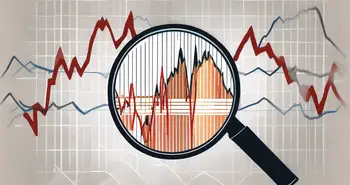The Dangers of Panic Selling: Strategies to Keep Calm and Hold Strong

Panic selling can be a nightmare for investors. It can induce a sense of fear and uncertainty that leads to hasty decision-making, which can have significant financial consequences in the long run. In this article, we will explore the various aspects of panic selling, its risks, the role of market volatility, strategies to avoid it, and the value of financial advisors in preventing panic selling.
Understanding Panic Selling
Panic selling is a phenomenon that occurs when investors rush to sell their investments in response to widespread fear or negative market sentiment. It is driven by emotional reactions, rather than rational analysis of market conditions. To gain a better understanding of this behavior, let's take a closer look at its definition and the psychological factors behind it.
While panic selling can have a significant impact on market dynamics, it is essential to delve deeper into the intricacies of this phenomenon to comprehend its full implications. By exploring real-life examples of panic selling in different financial markets, we can uncover the diverse triggers and consequences associated with such behavior. Understanding the historical context and patterns of panic selling can provide valuable insights into how investors can navigate turbulent times with more resilience and foresight.
Definition and Overview of Panic Selling
Panic selling refers to the mass exodus of investors from the market, resulting in a steep decline in stock prices. It can be triggered by various factors, including economic uncertainty, geopolitical tensions, or sudden changes in market conditions. The fear of losing money and the desire to minimize losses are the primary drivers of this behavior.
Moreover, examining the ripple effects of panic selling on different asset classes and investment instruments can shed light on the interconnected nature of financial markets. By analyzing the historical precedents of panic selling episodes and their aftermath, investors can gain a more nuanced understanding of the underlying mechanisms at play during periods of heightened market volatility.
The Psychology Behind Panic Selling
The psychology behind panic selling is rooted in fear, herd mentality, and emotional biases. When investors witness a market downturn or hear negative news, they may succumb to a sense of panic. This panic can spread like wildfire as other investors follow suit, leading to a self-reinforcing cycle of selling. The fear of missing out on potential gains also plays a role, as investors often rush to sell before prices drop further.
Furthermore, exploring the cognitive biases and behavioral patterns that contribute to panic selling can offer valuable insights into how investors can better manage their emotions and make more informed decisions during periods of market turbulence. By delving into the psychological underpinnings of panic selling, market participants can develop strategies to mitigate the impact of emotional responses on their investment portfolios and cultivate a more disciplined approach to risk management.
The Risks Associated with Panic Selling
Panic selling poses several risks that can have a lasting impact on an investor's financial well-being. Let's explore two key risks associated with this behavior.
Financial Consequences of Hasty Decisions
One of the immediate financial consequences of panic selling is the potential for significant losses. By selling during a market downturn, investors lock in their losses and miss out on potential gains when the market recovers. This can adversely affect their investment portfolio and overall financial position.
Long-term Impact on Investment Portfolio
Panic selling can have a long-term impact on an investor's investment portfolio. By succumbing to fear and selling off their investments, investors disrupt their long-term investment strategy and may miss out on the potential growth of their holdings. This can result in lower returns and hinder their progress towards achieving their financial goals.
Furthermore, panic selling can also lead to emotional distress and mental anguish for investors. Making decisions based on fear and panic rather than a rational assessment of market conditions can cause stress and anxiety, impacting not only their financial well-being but also their overall quality of life.
Another risk associated with panic selling is the potential for missed opportunities. When investors hastily sell off their assets in a panic, they may overlook the possibility of market rebounds or fail to capitalize on buying opportunities presented by lower asset prices. This can result in lost potential gains and hinder their ability to optimize their investment returns over time.
The Market Volatility and Panic Selling
Market volatility plays a significant role in triggering panic selling. Understanding the relationship between market fluctuations and panic selling can help investors navigate turbulent times more effectively.
One key aspect to consider is the psychological impact of market volatility on investors. The uncertainty and unpredictability that come with volatile market conditions can create a sense of unease and fear among market participants. This emotional response can lead to knee-jerk reactions, such as panic selling, as investors seek to mitigate their perceived risks. It is crucial for investors to recognize and manage their emotional responses during times of market volatility to avoid making hasty decisions that could negatively impact their long-term investment goals.
How Market Fluctuations Trigger Panic Selling
Market fluctuations, such as sudden drops in stock prices or increased volatility, can evoke fear and uncertainty among investors. This fear often prompts them to make impulsive decisions, such as panic selling, in an attempt to protect their investments. However, reacting solely based on short-term market movements can lead to suboptimal outcomes in the long run.
Moreover, market fluctuations can also be exacerbated by external factors, such as geopolitical events or economic indicators. These external influences can amplify market volatility and contribute to heightened levels of panic selling. It is essential for investors to stay informed about both internal and external factors that may impact market fluctuations and to maintain a diversified investment portfolio to mitigate risks associated with sudden market movements.
The Role of Media in Fueling Panic Selling
The media plays a crucial role in fueling panic selling by amplifying negative news. Sensational headlines, constant coverage of market downturns, and the prevalence of financial pundits predicting doomsday scenarios can instill fear in investors and prompt them to make rash decisions. It is important for investors to be aware of the media's influence and to maintain a rational perspective when making investment decisions.
Additionally, the rise of social media and online forums has also contributed to the spread of misinformation and herd mentality in the financial markets. Investors should exercise caution when consuming information from these sources and conduct thorough research to verify the credibility of the news before making any investment decisions. By critically evaluating information and maintaining a disciplined approach to investing, investors can better navigate market volatility and avoid succumbing to panic selling pressures.
Strategies to Avoid Panic Selling
Fortunately, there are strategies investors can employ to avoid falling into the trap of panic selling. Let's explore two key strategies that can help investors stay focused and disciplined during times of market turmoil.
Importance of Having a Solid Investment Plan
A solid investment plan serves as a guiding framework during turbulent times. It outlines an investor's goals, risk tolerance, and a well-diversified portfolio. By having a clear investment plan in place, investors can avoid making impulsive decisions based on short-term market movements and instead stay focused on their long-term objectives.
Emotional Control and Discipline in Investing
Emotional control and discipline are crucial attributes for successful investing. By acknowledging and understanding the emotions that drive their investment decisions, investors can strive to maintain a level-headed approach. This involves staying rational, avoiding knee-jerk reactions to market volatility, and sticking to their investment plan even during challenging times.
The Role of Financial Advisors in Preventing Panic Selling
During times of market turbulence, financial advisors can provide invaluable guidance and support to investors. Let's explore how their expertise can help investors navigate the stormy waters of panic selling.
How Advisors Can Help Maintain Investment Objectivity
Financial advisors act as a voice of reason and objectivity for investors. They can provide a broader perspective on market conditions, help investors stay focused on their long-term goals, and prevent them from succumbing to emotional biases. Advisors can also offer alternative investment strategies or asset allocation adjustments tailored to an investor's risk profile, which can help mitigate the impact of market volatility.
The Value of Professional Guidance During Market Downturns
Professional guidance during market downturns can be instrumental in preventing panic selling. Financial advisors can leverage their expertise and experience to assess market conditions, identify investment opportunities, and recommend adjustments to an investor's portfolio. Their role in providing emotional support and instilling confidence can also help investors stay the course during challenging market conditions.
FAQ: Recap of the Main Points
To summarize, panic selling poses significant risks for investors, both in terms of immediate financial consequences and long-term impact on investment portfolios. Market volatility and media influence play a role in triggering panic selling, but strategies such as having a solid investment plan and maintaining emotional control can help investors avoid falling into this trap. Financial advisors can offer valuable guidance and support, ensuring investors maintain investment objectivity and navigate market downturns with confidence.
As you consider the strategies to combat the risks of panic selling, remember that the right platform can make a significant difference. Morpher.com stands out as a revolutionary trading platform that empowers you with zero fees, infinite liquidity, and the ability to engage in fractional investing and short selling. With the added security of a non-custodial wallet and the potential to leverage trades up to 10x, Morpher offers a unique trading experience tailored to your needs. Don't let market volatility dictate your financial future. Sign Up and Get Your Free Sign Up Bonus today, and take the first step towards a more controlled and innovative approach to investing.

Disclaimer: All investments involve risk, and the past performance of a security, industry, sector, market, financial product, trading strategy, or individual’s trading does not guarantee future results or returns. Investors are fully responsible for any investment decisions they make. Such decisions should be based solely on an evaluation of their financial circumstances, investment objectives, risk tolerance, and liquidity needs. This post does not constitute investment advice.

Painless trading for everyone
Hundreds of markets all in one place - Apple, Bitcoin, Gold, Watches, NFTs, Sneakers and so much more.

Painless trading for everyone
Hundreds of markets all in one place - Apple, Bitcoin, Gold, Watches, NFTs, Sneakers and so much more.









